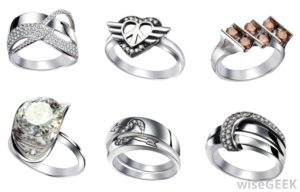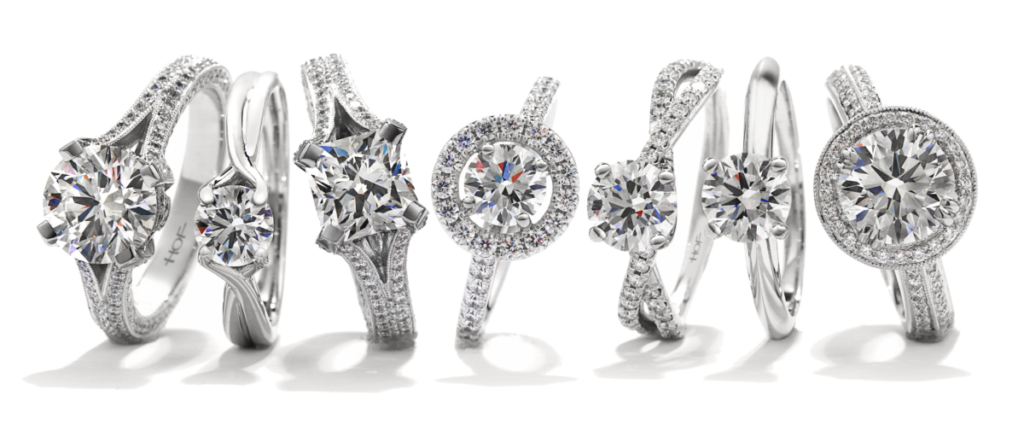“White gold” is the name given to the alloy formed when gold is mixed with metals like silver, nickel and palladium. It became fashionable during the 1920s as a substitute for the more expensive platinum. It is usually of 9, 14 or 18 carats, but it can come in other grades also. While 18 carat yellow gold comprises of 75% gold and 25% copper or zinc, 18 carat white gold comprises of 75% gold and 25% silver, nickel or palladium. Hence lower carats would indicate a lesser quantity of gold in the alloy.
If you are on the lookout for ornaments in white gold, there are some facts that you should be aware of in order to get the best value for your money. Pure 24 carat gold in its original form has a deep yellow color, and since it is very yielding and flexible, it has to be mixed with suitable other metals to make it a more stable and usable alloy. The gold content varies in each case from 33.3% (8 carats) to 91.6% (22 carats), and, depending on the metal used to form the alloy, the resultant colors range from yellow, pale yellow, deep yellow, pink (or rose) yellow, reddish yellow, greenish yellow, purple gold – which is quite rare – and white gold. Each has its own physical and chemical properties.
White gold
 White Gold is the name given to the alloy formed when gold is mixed with metals like silver, nickel and palladium. It became fashionable during the 1920s as a substitute for the more expensive platinum. It is usually of 9, 14 or 18 carats, but it can come in other grades also. While 18 carat yellow gold comprises of 75% gold and 25% copper or zinc, 18 carat white gold comprises of 75% gold and 25% silver, nickel or palladium. Hence lower carats would indicate a lesser quantity of gold in the alloy.
White Gold is the name given to the alloy formed when gold is mixed with metals like silver, nickel and palladium. It became fashionable during the 1920s as a substitute for the more expensive platinum. It is usually of 9, 14 or 18 carats, but it can come in other grades also. While 18 carat yellow gold comprises of 75% gold and 25% copper or zinc, 18 carat white gold comprises of 75% gold and 25% silver, nickel or palladium. Hence lower carats would indicate a lesser quantity of gold in the alloy.
Since there is no clear cut definition of how white the white gold alloy should be, ornaments come in different shades and quality. All white metals – like palladium, platinum, nickel, silver, zinc, etc. – form a white colored alloy when added to gold. While the first three have a strong whitening effect, the second two have a milder outcome. Other whitening metals have very little impact. In the final analysis there are two main categories of white gold: the Nickel whites and the Palladium whites. 9-carat white gold has 37.5% gold content and is very white and reasonably flexible. This grade is very popular among jewelers. The range continues up to 21 carats. Make a careful study of the carats, the composition and the prices before finalizing your choice.
Nickel White gold
Nickel White gold alloys are quite hard and strong, but jewelry craftsmen find it quite complex to work with, especially because of the phenomenon called ‘firecracking’. The commercial variety comprises of a gold-nickel-silver-zinc alloy. Sometimes copper is added to make it more flexible, but this tends to darken the color. Rhodium plating will overcome this problem. The following table will give you an idea of the composition of some standard nickel white gold alloys:
| Gold, % wt |
Copper, % wt |
Nickel, % wt |
Zinc, % wt |
Hardness Hv |
Liquidus °C |
|
| 18ct | 75 | 2.2 | 17.3 | 5.5 | 220 | 960 |
| 75 | 8.5 | 13.5 | 3.0 | 200 | 955 | |
| 75 | 13.0 | 8.5 | 3.5 | 150 | 950 | |
| 14ct | 58.5 | 22.0 | 12.0 | 7.4 | 150 | 995 |
| 10ct | 41.7 | 32.8 | 17.1 | 8.4 | 145 | 1085 |
| 9ct | 37.5 | 40.0 | 10.5 | 12.0 | 130 | 1040 |
Since nickel is known to cause allergic reactions in around 20% of white gold users, especially women, manufacturers of the alloy are avoiding the metal and show a marked preference for silver and palladium. In January 2000 EU countries initiated legislative measures imposing restrictions on the use of nickel in jewelry. In the USA manufacturers are required to specify whether or not their products contain nickel. You must enquire whether the white gold ornaments you are buying contain nickel or not.
Palladium white gold
Palladium white gold is more expensive than the nickel variety because the metal itself is more costly – in fact costlier than gold. The heavy palladium is also denser and this means the jewelry will require a higher gold content and will consequently be heavier – adding to the cost even further. Since melting temperatures are considerably higher, the manufacturing process itself is more complicated. Craftsmen add between 10 to 12% palladium to the alloy to give a quality white color to jewelry. But most commercial varieties contain only between 6 to 8 % palladium, with silver, zinc and copper added proportionately. Some grades of palladium white gold contain nickel.
The palladium variety of white gold jewelry is available in up to 21 carats. It has a tendency to be more yielding and flexible in comparison to nickel white gold. The following table will give you an indication of some of the standard palladium white gold compositions:
| G | P | S | C | Z | N | Hardn Hv |
Liq, °C |
|
| 18ct | 75 | 20 | 5 | – | – | – | 100 | 1350 |
| 75 | 15 | 10 | – | – | – | 100 | 1300 | |
| 75 | 10 | 15 | – | – | – | 80 | 1250 | |
| 75 | 10 | 10.5 | 3.5 | 0.1 | 0.9 | 95 | 1150 | |
| 75 | 6.4 | 9.9 | 5.1 | 3.5 | 1.1 | 140 | 1040 | |
| 75 | 15 | – | 3.0 | – | 7.0 | 180 | 1150 | |
| 14ct | 58.3 | 20 | 6 | 14.5 | 1 | – | 160 | 1095 |
| 58.5 | 5 | 32.5 | 3 | 1 | – | 100 | 1100 | |
| 10ct | 41.7 | 28 | 8.4 | 20.5 | 1.4 | – | 160 | 1095 |
| 9ct | 37.5 | – | 52 | 4.9 | 4.2 | 1.4 | 85 | 940 |
G-gold, P-palladium, S-silver, C-copper, Z-zinc, N-nickel. [In wt %]
Other varieties of white gold
 Other Varieties have been developed as the demand for cheaper substitutes for the expensive nickel-free palladium whites is increasing. This is most evident in the EU countries. Most of the new alloys being introduced in the jewelry sector use manganese as the whitening agent. Most have a very low palladium content and some even have no palladium at all. Chromium and iron also are used as whitening agents, but these products are hard and are not easy to process.
Other Varieties have been developed as the demand for cheaper substitutes for the expensive nickel-free palladium whites is increasing. This is most evident in the EU countries. Most of the new alloys being introduced in the jewelry sector use manganese as the whitening agent. Most have a very low palladium content and some even have no palladium at all. Chromium and iron also are used as whitening agents, but these products are hard and are not easy to process.
Most of these alternates to nickel and palladium whites are of comparatively inferior quality. They need to be plated with rhodium, as the white color is not good. They have a tendency to tarnish quickly and also to develop cracks.
Whether you buy palladium, nickel or other varieties of white gold, in order to give the grayish colored ornaments a lighter hue, they are generally coated with rhodium, which bears a strong resemblance to platinum in color and other properties. (Platinum is heavier, denser and far more enduring than gold. It is also a lot more expensive.) The white colored rhodium coating wears out with use and you need to have your ornaments re-plated as and when necessary. Most local jewelry stores will be able to do the job for you at reasonable rates. And be sure you make your purchases from a reliable jeweler.
Source: https://www.jewelinfo4u.com/white-gold-2

